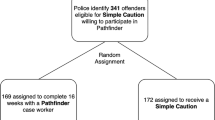Abstract
Habitual offender acts have been adopted by 43 states and are under consideration in the legislatures of others. These acts have been adopted with relatively little evaluation of the costs involved in the implementation of this legislation. This study seeks to evaluate the extent to which Alabama’s habitual offender statute captures serious career criminals. The results indicate that the differences between those in the prison population sentenced under habitual offender statutes and those sentenced under other statutes is not significant. There does appear to be support for the contention that the majority of prisoners have substantial criminal histories; however, it is noted that many have not committed a severe crime.
The exaggerated claims for the number of crimes committed by “typical” offenders and resultant high costs of non-incarceration are examined and challenged. The authors suggest that the resources available to deal with offenders could be better invested in the development and testing of community-based programs designed to divert offenders from a life of crime rather than in programs which intervene after criminal histories are severe and which invoke life-long incarceration as a remedy.
Similar content being viewed by others
Bibliography
Bender, D., B. Leone, and B. Szumski (1985) America’s Prisons. St. Paul, MN: Breenhaven Press.
Blackmore, J., and J. Welsh (1983) Selective incapacitation: Sentencing according to risk. Crime and Delinquency. 29(4), 505–527.
Blumstein, A., and J. Kadane (1983) An approach to the allocation of scarce imprisonment resources. Crime and Delinquency. 29(4), 546–559.
Carney, L. (1980) Corrections: Treatment and Philosophy. Englewood Cliffs, NJ: Prentice Hall.
Flanagan, T. (1982) Correctional policy and the long-term prisoner. Crime and Delinquency. 28(1), 82–95.
Flanagan, T. (1985) Sentence planning for Long-term Inmates. Federal Probation. 49(3), 23–28.
Flanagan, T., and McGarrell (Eds.) (1986) Sourcebook of criminal justice statistics-1985. (U.S. Department of Justice, Bureau of Justice Statistics). Washington, DC: U.S. Government Printing Office.
Gottfredson, M., and T. Hirschi (1986) The true value of lambda would appear to be zero: An essay on career criminals, criminal careers, selective incapacitation, cohort studies, and related topics. Criminology, 24(2), 213–233.
Greenfield, L. (1985) Examining recidivism. Washington, DC: U.S. Government Printing Office.
Greenwood, P., J. Chaiken, J. Petersilia, and M. Peterson (1978) The Rand Habitual Offender Project: A Summary. Santa Monica, CA: Rand Corporation.
Inciardi, J. (1986) Criminal Justice. New York: Harcourt Brace, Jovanovich.
Irwin, D. (1981) Sociological studies of the impact of long-term confinement. In D. Ward & K. F. Schoen (Eds.) Confinement in Maximum Custody. Lexington, MA: Lexington Books.
Janus, M. (1985) Selective incapacitation: Have we tried it? Does it work? Journal of Criminal Justice. 3, 117–129.
Langan, P., and L. Greenfeld (1983) Career patterns in crime. Washington, DC: U.S. Department of Justice, Bureau of Statistics.
MacKenzie, D. L., G. S. Tracy, and G. Williams (1988) Incarceration rates and demographic change hypothesis. Journal of Criminal Justice. 16(3), 212–253.
Monahan, J. (1981) Identifying chronic criminals. In D. Ward and K. F. Schoen (Eds.), Confinement in Maximum Custody (NCJ-77087). Lexington, MA: D. C. Heath and Company.
Morris, N. (1951) The Habitual Criminal. Cambridge: Harvard University Press.
Peck, D., and R. Jones (1981) The High Cost of Alabama’s Habitual Felony Offender Act: A Preliminary Assessment. International Journal of Offender Therapy and Comparative Criminology. 29(3): 251–264.
Petersilia, J., P. Honig, and C. Huboy (1980) Prison Experience of Career Criminals. Washington, DC: U.S. Department of Justice.
Peterson, M., H. Braiker and R. Polich (1980) Doing Crime. Washington, DC: U.S. Department of Justice, National Institute of Justice.
Radzinowicz, L., and R. Hood (1980) Incapacitating the habitual criminal: The English experience. Michigan Law Review. 78(3), 1305.
Research, Monitoring, and Evaluation (1987). Considerations and consequences of the HOA, LWOP, and CIT. Montgomery, AL: Alabama Department of Corrections.
Shinnar, E., and K. Shinnar (1975) The effects of the criminal justice system on the control of crime: A qualitative approach. Law and Society Review. 23(4), 547.
U.S. Department of Justice (1987). BJS data report, 1986 (Bureau of Justice Statistics). Washington, DC: U.S. Government Printing Office.
U.S. Department of Justice (1985) Criminal victimization in the United States-1983 (Bureau of Justice Statistics). Washington, DC: U.S. Government Printing Office.
U.S. Department of Justice (1986) Criminal victimization in the United States--1984 (Bureau of Justice Statistics). Washington, DC: U.S. Government Printing Office.
U.S. Department of Justice (1983) Setting prison terms. Washington, DC: Bureau of Justice Statistics.
Wolfgang, M., M. Figlio and T. Sellin (1972) Delinquency in a Birth Cohort. Chicago: University of Chicago Press.
Zedlewski, E. W. (1987) Making confinement decisions (Research in Brief). Washington, DC: National Institute of Justice.
Author information
Authors and Affiliations
Additional information
The authors wish to express their appreciation to the Alabama Department of Corrections for their assistance in this project.
Rights and permissions
About this article
Cite this article
Sigler, R., Culliver, C. Effectiveness of the habitual offender act: An assessment of criminal histories. AJCJ 15, 105–121 (1990). https://doi.org/10.1007/BF02887459
Issue Date:
DOI: https://doi.org/10.1007/BF02887459




